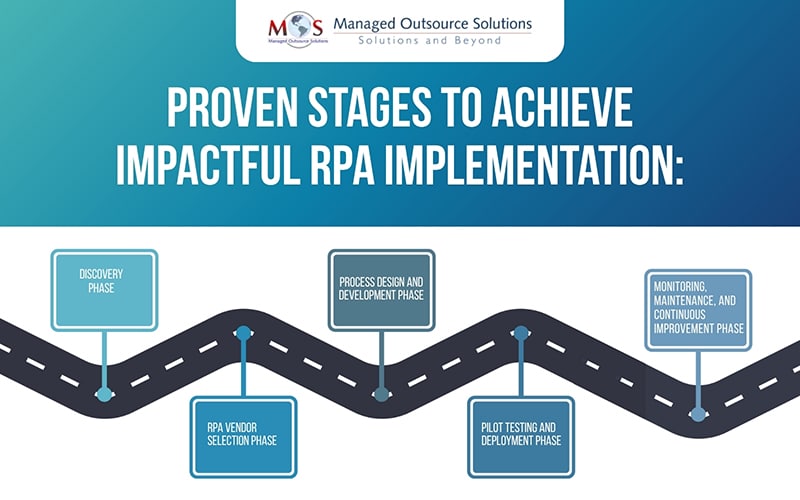Amid rising operational expenses, stricter regulations, and competitive marketplace, businesses are striving to discover optimal strategies to maximize efficiency. One key technology organizations across all sectors are increasingly adopting to achieve this is robotic process automation (RPA). Many companies deploy this software with the expectation that it will eliminate mundane tasks like manual data entry, rectify process defects, reduce operational hurdles, and optimize productivity and efficiency. While RPA definitely plays a crucial role in streamlining operations, adoption alone doesn’t guarantee success.
To enable successful automation, businesses must establish a strategic RPA implementation roadmap tailored to each stage of their organization. For companies hesitant to manage the complexities of in-house deployment, partnering with a reliable robotic process automation company is a viable alternative that minimizes risk and accelerates outcomes.
Let’s go through each stage involved in an end-to-end robotic process automation deployment plan.
A Practical Step-by-Step RPA Implementation Guide
Before launch, companies should build a high-level RPA plan that outlines key objectives, challenges, goals, and deadlines to serve as a blueprint throughout the adoption process. This digital transformation roadmap provides a structured framework for task prioritization, assigning team roles, resource allocation and expected outcomes.
A proactive approach to bot implementation not only actively addresses potential risks but also track progress, control costs, and ensure long-term sustainability of automation projects.
Given below are the key stages for guiding RPA initiatives from start to finish:
- Discovery Phase
The initial discovery phase defines the automation’s scope, parameters, and focus areas RPA will impact. Identifying the ideal “candidates” for business process automation holds the key to success as not all processes are suitable for RPA.
Automating low-priority, intricate tasks demanding human creativity can lead to catastrophic results such as increased errors, workflow delays, and lost revenue.
Key considerations when choosing tasks for automation:
- Conduct process analysis – RPA team should perform a process analysis to identify the ideal tasks fit for automation. Prioritize rule-based, repetitive, and high-volume tasks that are prone to human errors and hinder productivity. Organizations should select processes that are efficient, free of bottlenecks, and prioritize them based on factors such as criticality, feasibility, and scalability.
- Consult stakeholders – Confirm alignment with key stakeholders such as senior management, project leaders, IT professionals, and internal business units. Considering their inputs helps to validate process selection, gather insights on operational constraints, and meet business priorities.
- Estimate potential ROI – Calculate the expected return on investment by evaluating cost savings, efficiency gains, error reduction, and resource optimization. This will help prioritize processes that deliver the highest business impact.
The groundwork laid during this phase acts as a foundation for scalability, efficiency, and long-term success.
- RPA Vendor Selection Phase
The next step is choosing the suitable RPA vendor to support the organization’s automation journey. Although developing an RPA project internally may provide greater control and customization, it may not always be practical due to heavy upfront investments in time, resources, and capital required. Selecting the right partner is critical as the vendor’s capabilities, expertise, and tools directly influence the scalability, usability, and overall success of the initiative. With multiple providers in the market, businesses must carefully evaluate their options before making a decision.
Key considerations include:
- Assess vendor capabilities – Evaluate the vendor’s technical expertise, product features, integration capabilities, and security measures. Verify whether the platform supports enterprise-wide scalability, advanced analytics, and governance.
- Check industry experience – Choose a vendor with proven experience in your industry. A partner familiar with domain-specific challenges can provide tailored solutions and best practices.
- Consider total cost of ownership (TCO) – Explore licensing package and pricing models to determine if they are flexible and accommodating to your budgets. Also analyze costs related to implementation, infrastructure, maintenance, and upgrades for transparency and accurate ROI estimation.
- Evaluate support – Strong post-deployment support, user training, and ongoing updates are vital for long-term success. Confirm that the vendor offers dedicated assistance and a solid knowledge base by reviewing past client testimonials, case studies, and references to validate the vendor’s track record.
Objective RPA vendor evaluation not only increases the likelihood of the right technical fit but also fosters a long-term partnership that supports innovation, resilience, and future automation goals.
- Process Design and Development Phase
Companies need to collaborate with their selected RPA vendor to design customized robotic process workflow that is logical, intuitive, and scalable. Program the software bots to mimic human actions such as data entry, validation, calculations, and report generation within the existing systems. This phase transforms the strategic blueprint created during the design stage into actual automated solutions that align with business objectives. Key considerations include:
- Build detailed process maps – Document step-by-step workflows, rules, and decision points that define how bots will operate. This ensures transparency and consistency across all automated tasks.
- Develop automation scripts – Work closely with vendor specialists and in-house teams to build, configure, and test automation scripts tailored to organizational needs. Implement exception handling capabilities for effective bot management in the event of failures or errors.
- Enable scalability – Design bots with flexibility in mind so they can adapt to process changes, increased transaction volumes, and evolving business needs.
- Maintain compliance and security – Embed regulatory compliance, data privacy, and security requirements into automation workflows to safeguard sensitive information.
A well-executed development phase ensures that automation not only delivers efficiency but also aligns long-term business objectives.
- Pilot Testing and Deployment Phase
Before rolling out RPA solutions across the enterprise, companies must conduct a pilot test in a phased manner to validate performance, stability, and scalability in a controlled environment. Commence the pilot phase with a rollback plan using one or two processes to identify unexpected gaps, detect errors, and fine-tune workflows before full-scale deployment. Once the pilot testing is successful, businesses can proceed with phased deployment to ensure minimal disruption and impactful adoption. Key considerations include:
- Run pilot programs – Select a small set of high-priority processes and test them across various real-world conditions. Monitor accuracy, speed, and error rates to validate effectiveness of the RPA system.
- Gather feedback – Involve end-users, IT teams, and process owners during pilot runs. Their insights help detect usability issues and guide further improvements.
- Fine-tune workflows – Address process gaps, optimize scripts, and refine automation rules based on pilot outcomes to improve overall performance and ensure system works as intended under diverse scenarios.
- Adopt phased rollout – Gradually expand deployment to different departments or business units to avoid wide-scale disruptions. A step-by-step approach minimizes risks and ensures seamless integration with existing systems.
A successful pilot testing automation process followed by carefully planned deployment ensures not only smooth adoption but also paves the way for enterprise-wide RPA transformation.
- Monitoring, Maintenance, and Continuous Improvement Phase
Once bots are deployed, continuous RPA monitoring and maintenance is essential to ensure sustainable success. Software bots, like any other technology, require regular oversight to handle exceptions, adapt to process changes, and maintain compliance. Organizations should view RPA as an evolving capability rather than a one-time deployment. Key considerations include:
- Track performance metrics – Measure KPIs such as accuracy rates, cycle times, error reduction, cost savings, and employee productivity to gauge automation effectiveness.
- Manage exceptions – Monitor for scenarios where bots cannot complete tasks due to data irregularities or process changes, and implement exception-handling protocols.
- Ensure compliance – Regularly audit automated workflows to confirm adherence to industry regulations, security standards, and organizational policies.
- Update and optimize bots – Modify and enhance automation scripts as business needs evolve. Continuous optimization ensures bots stay relevant and effective.
By continuously monitoring and refining automation, organizations can maximize ROI, improve resilience, and scale RPA alongside business growth.
Power Your Automation Goals through Outsourcing
RPA implementation is a game-changing technology that accelerates digital transformation, drives business agility, and enhances operational efficiency. Since deploying RPA bots requires additional investments in terms of infrastructure, expertise, and ongoing maintenance, many organizations turn to RPA services for external support.
By leveraging the specialized skills and proven methodologies of cost-effective robotic process automation solutions, businesses can eliminate implementation risks, lower costs, and achieve faster time-to-value. Outsourcing also enables enterprises to focus on their core operations while scaling automation seamlessly across departments.





